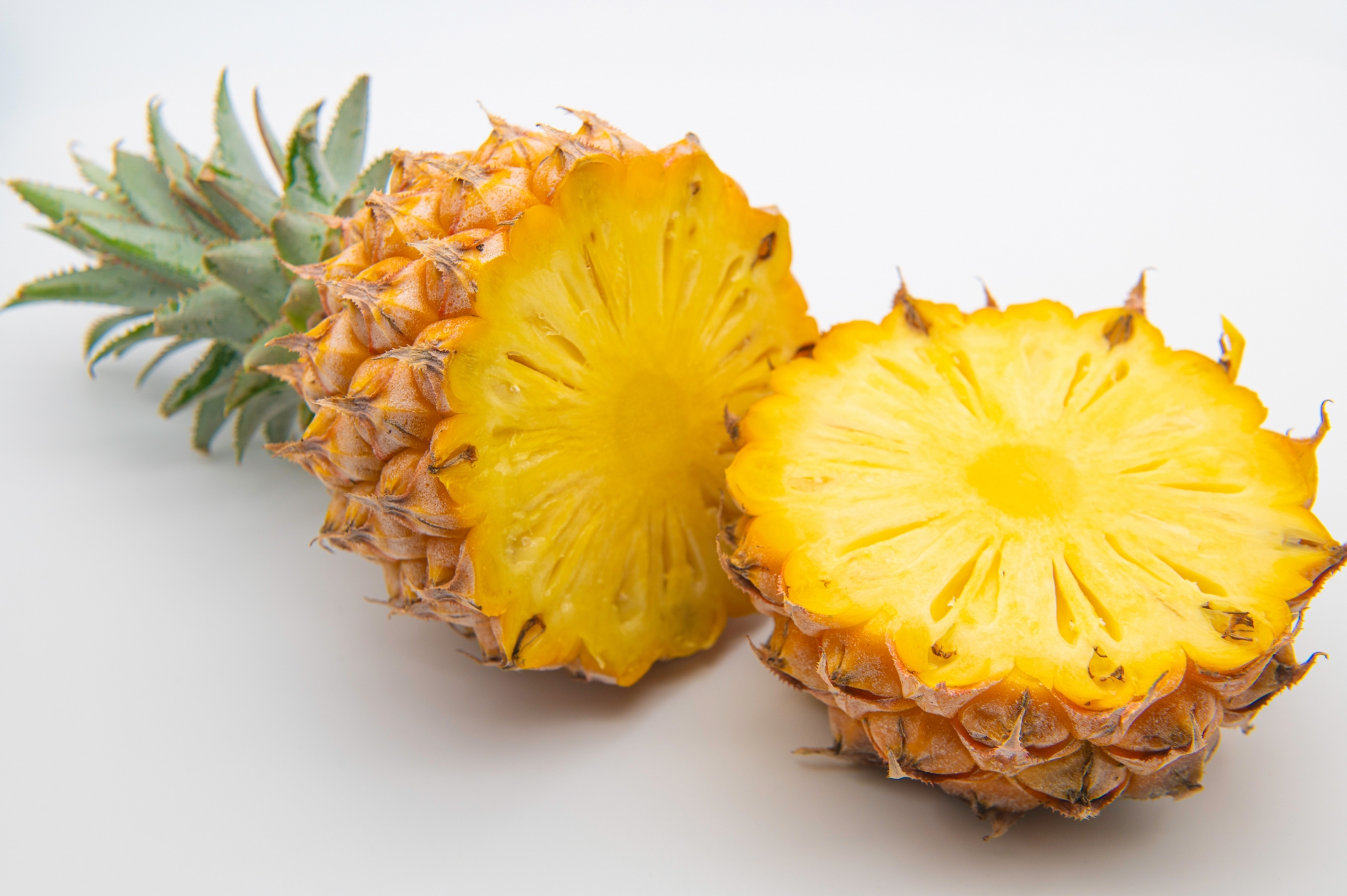Functionality of pineapple ceramide
functionalMelanin-suppressing effect
We investigated the effect on melanin production, which causes hyperpigmentation, using a three-dimensional skin model containing melanocytes.
The results showed that treatment with pineapple ceramides suppressed melanin production in the 3D skin model.
Although pineapple ceramides do not have a direct effect, they can indirectly support this effect by enhancing skin hydration and barrier function. Insufficient skin hydration leads to skin dryness and roughness, which causes hyperpigmentation and dullness. Pineapple ceramides help maintain skin moisture, thereby preserving skin health and preventing hyperpigmentation and dullness.
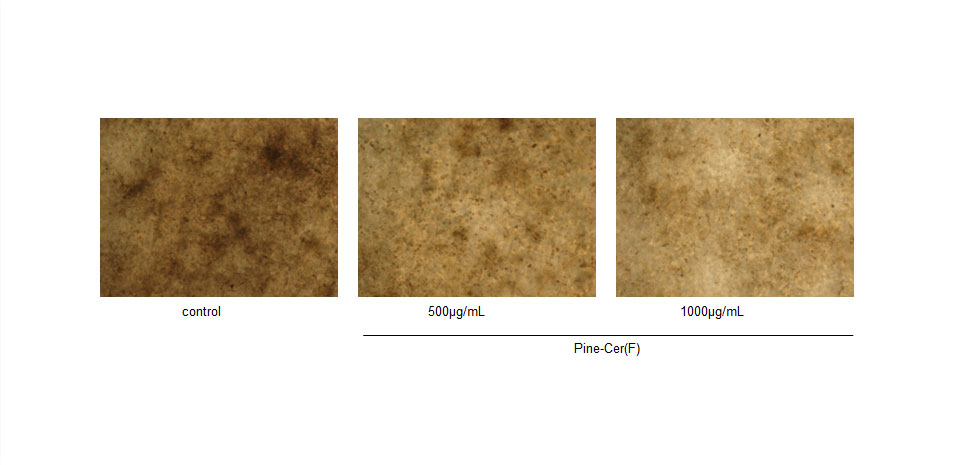
Anti-wrinkle effect
The effect on wrinkle formation caused by UV exposure was examined using hairless mice.
Mice that were administered dietary-grade pineapple ceramides showed significant suppression of wrinkle formation compared to untreated mice.
Pineapple ceramides do not have a direct anti-wrinkle effect, but they can help prevent skin aging and wrinkle formation through the following mechanisms.
Moisturizing effect on the skin: When skin hydration is insufficient, its elasticity decreases, increasing the likelihood of wrinkles and sagging. Pineapple ceramides help maintain skin moisture, which supports skin elasticity and contributes to the prevention of wrinkle formation.
Enhancement of the skin’s barrier function: Strengthening the skin’s barrier function helps protect it from UV rays and external irritants. Since damage caused by UV exposure and external stimuli contributes to skin aging and wrinkle formation, protecting the skin in this way supports the prevention of wrinkles.
Promotion of skin turnover: Citric acid contained in pineapple ceramides helps remove dead skin cells. By eliminating old keratin, it promotes skin turnover, supports skin elasticity, and contributes to the prevention of wrinkles.
As described above, pineapple ceramides can help prevent skin aging and wrinkle formation by maintaining skin hydration, enhancing the skin’s barrier function, and promoting skin turnover.
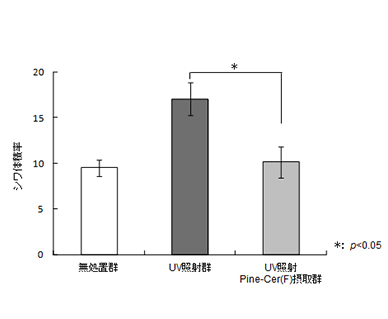
Moisturizing Effect
Hyaluronic acid produced by cells in the dermis and proteins involved in water transport within skin cells, such as aquaporins, play important roles in skin moisture retention. We investigated the enhancement of hyaluronic acid production and the activation of proteins involved in water transport within skin cells by treatment with cosmetic-grade pineapple ceramides, by examining gene expression.
Treatment with pineapple ceramides resulted in increased mRNA expression levels of hyaluronic acid synthase and aquaporins, indicating an enhancement of moisturizing effects.
Pineapple ceramides are ingredients with excellent moisturizing effects and have a structure very similar to natural ceramides found in the stratum corneum of the skin surface. The stratum corneum is rich in ceramides, whose role is to suppress skin moisture evaporation. However, aging and external stimuli cause a decrease in ceramide levels, resulting in reduced skin moisture retention. Therefore, using cosmetics containing pineapple ceramides can enhance the skin’s moisturizing ability.
Pineapple ceramides also contain moisturizing components such as glycerin and naturally derived amino acids, which provide hydration and enhance the skin’s moisture retention. Additionally, pineapple ceramides form a film on the skin’s surface, preventing skin moisture evaporation and providing the effect of supplying hydration to the skin. In this way, pineapple ceramides improve the skin’s moisturizing ability, prevent dryness and itching, and contribute to maintaining overall skin health.
Furthermore, by enhancing skin suppleness, pineapple ceramides help maintain skin firmness and elasticity, which contributes to the prevention of skin aging and wrinkle formation. Therefore, using cosmetics containing pineapple ceramides can help keep the skin healthy and maintain a beautiful, youthful appearance.
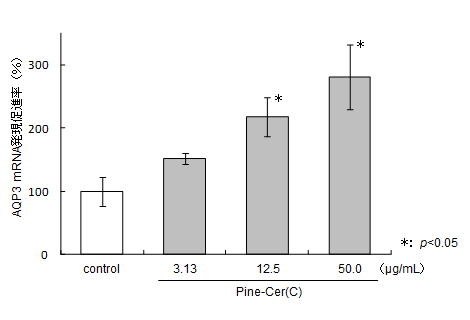
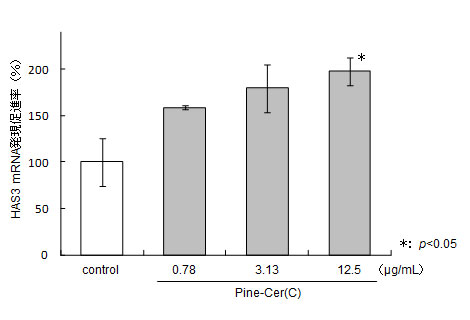
Barrier Function Enhancement Effect
Ceramides form a crucial structure in the skin’s barrier function. A deficiency of ceramides indicates a reduction in barrier function.
We investigated the ceramide production-promoting effect of pineapple ceramide treatment using a three-dimensional skin model.The three-dimensional skin model treated with pineapple ceramides showed an increase in ceramide levels.
Pineapple ceramides have the effect of enhancing the skin’s barrier function. The skin’s barrier function is a function of the skin that serves to protect it from external irritants, dryness, and other factors; it plays a role in preventing moisture loss and shielding the skin from external stimuli.
Pineapple ceramides have a structure similar to that of ceramides and penetrate the stratum corneum to strengthen the skin’s barrier function. They also form a thin protective film on the skin’s surface, helping to shield the skin from external irritants and dryness. This protective layer retains essential moisture and provides hydration, thereby enhancing the skin’s barrier function.
In addition, pineapple ceramides have moisturizing effects that enhance the skin’s ability to retain moisture and improve its barrier function. When the skin is dry, its barrier function weakens, making it more susceptible to external irritants. However, when the skin is well moisturized, the barrier function is strengthened, helping to maintain skin elasticity and health.
As described above, pineapple ceramides help enhance the skin’s barrier function and support the maintenance of overall skin health.
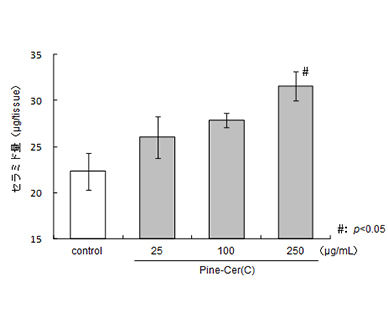
Reference: Frontier Science of Beautiful Skin, CMC Publishing
Supervisor

- President
- Born in Gunma Prefecture in 1965, he completed his doctoral studies at the Graduate School of Agricultural Science at Tokyo University of Agriculture (PhD), and served as a special research fellow at the Japan Society for the Promotion of Science, a part-time lecturer at Tokyo University of Agriculture, and an associate professor and professor at Takasaki University of Health and Welfare before becoming a professor at Tokyo University of Agriculture in April 2012. He is a professor at the same graduate school, and will be the president of Tokyo University of Agriculture in April 2021. He will be the chairman of Tokyo University of Agriculture in July 2023.
School he attended
April 1984 - March 1988 Graduated from the Department of Forestry (Forestry Science Course), Faculty of Agriculture, Tokyo University of Agriculture
Degrees he received
Tokyo University of Agriculture - Doctor of Forestry
Career history within the university
April 2012 - Ongoing Professor, Department of Forest Science, Faculty of Regional Environmental Science, Tokyo University of Agriculture
April 2016 - Ongoing Director, Food and Agriculture Museum, Tokyo University of Agriculture (Other organizations)
April 2021 - Ongoing President, Tokyo University of Agriculture
Academic societies and committees he has been affiliated with
April 1985 - Ongoing Japan Wood Research Society
June 1988 - Ongoing Japanese Mushroom Society
April 1995 - Ongoing Japanese Society of Inflammatory and Regenerative Medicine
April 1995 - Ongoing Japanese Society of Bioscience, Biotechnology, and Agricultural Chemistry
May 1995 - Ongoing Applied Pharmacology Research Society
Latest Posts
- November 27, 2025 Functionality of pineapple ceramide Clinical trial: Effects on moisturizing efficacy
- October 30, 2025 Functionality of pineapple ceramide Pineapple Cultivation and Nutritional Value
- September 30, 2025 Functionality of pineapple ceramide Storage Methods and Tips for Maintaining the Freshness of Pineapple
- August 27, 2025 Functionality of pineapple ceramide Mechanisms of Melanin Suppression and Spot Prevention by Pineapple Ceramide
- February 19, 2025 Functionality of pineapple ceramide Possibility of ceramide, a component derived from pineapple
その他機能について
- Clinical trial: Effects on moisturizing efficacy
- Pineapple Cultivation and Nutritional Value
- Storage Methods and Tips for Maintaining the Freshness of Pine...
- Mechanisms of Melanin Suppression and Spot Prevention by Pinea...
- Possibility of ceramide, a component derived from pineapple
- The effects of pineapple ceramide on the skin’s barrier functi...

OUTLINE
Supervisor
Message from the Founder
With the growing popularity of Foods for Specified Health Uses and the newly established Functional Labeling Food system by the Consumer Affairs Agency, people are increasingly seeking not only to satisfy hunger and taste but also to achieve health and beauty benefits through food. As someone involved with agricultural products, I have been amazed by the many newly discovered functional components. It was particularly fascinating to find beauty-related components in pineapples, a fruit with a long history of consumption, which no one had expected. I believe that such research achievements should be more widely discussed and further developed.
About the Pineapple Ceramide Research Association
This research association was established to provide a platform for publishing research findings on the functionality of pineapple ceramides and for exchanging information and opinions for further study.
Biography
- Born in 1965 in Gunma Prefecture. Completed the doctoral program at the Graduate School of Agriculture, Tokyo University of Agriculture (Ph.D.). Served as JSPS Research Fellow, part-time lecturer at Tokyo University of Agriculture, associate professor and professor at Takasaki University of Health and Welfare. Appointed as professor at Tokyo University of Agriculture in April 2012 and graduate advisor.
- Appointed President of Tokyo University of Agriculture in April 2021.
- Appointed Chairman of the Board of Trustees in July 2023.
Education
- April 1984 – March 1988: Graduated from the Department of Forestry (Wood Science Course), Faculty of Agriculture, Tokyo University of Agriculture.
Degree
- Ph.D. (Forestry), Tokyo University of Agriculture
Academic Career
- April 2012 – Present: Professor, Department of Forest Science, Faculty of Regional Environmental Science, Tokyo University of Agriculture
- April 2016 – Present: Director, “Museum of Food and Agriculture,” Tokyo University of Agriculture (other affiliated organizations)
- April 2021 – Present: President, Tokyo University of Agriculture









